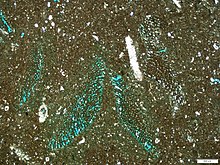Type a search term to find related articles by LIMS subject matter experts gathered from the most trusted and dynamic collaboration tools in the laboratory informatics industry.


Floatstone is a type of carbonate rock.
The original Dunham classification (Dunham, 1962[1]) of limestones did not consider the separate classification of coarse grained carbonate lithologies. In an attempt to rectify this, Embry & Klovan (1971[2]) introduced the terms rudstone (grain supported) and floatstone (matrix supported) for coarse-grained allochthonous limestones. This definition of a floatstone was most recently clarified as "a carbonate-dominated rock where more than 10% of the volume is grains larger than 2 mm and the fabric is supported by the component that is 2 mm and smaller".[3]